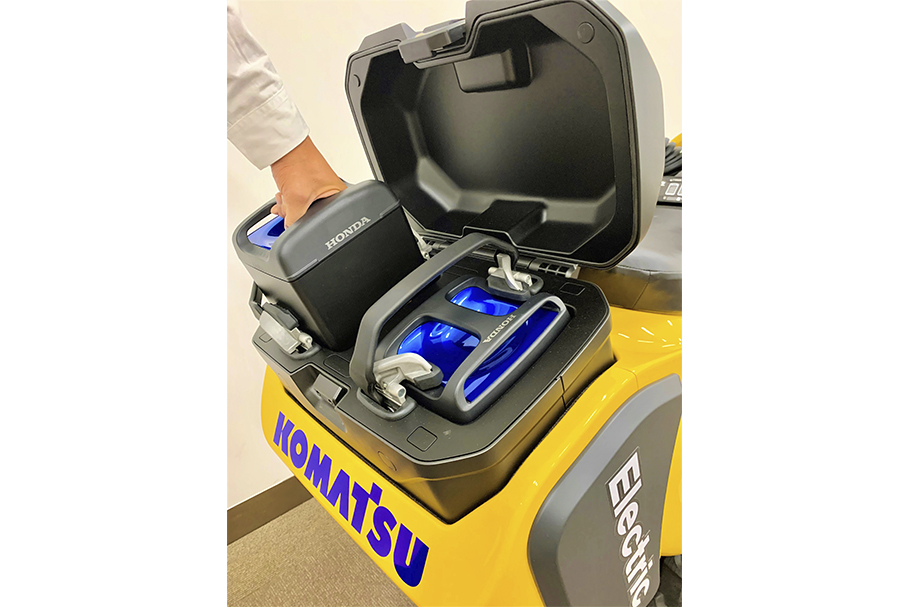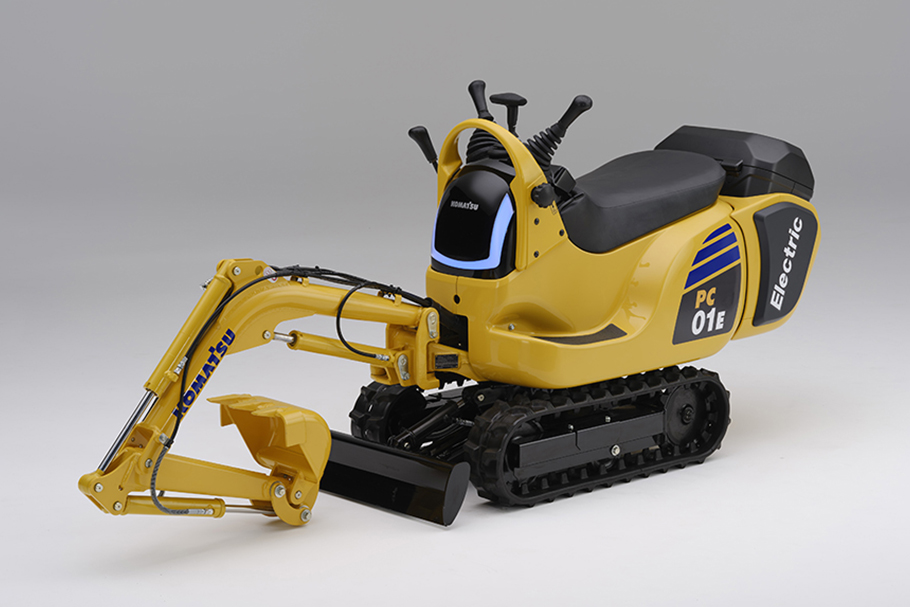Last month Honda and Komatsu signed an agreement to develop an electric version of Komatsu’s PC-01 “mini excavator”, the PC-01E. The picture shown here lacks anything to give us a sense of scale, which might make it look like a toy. It is actually a rideable thingy which is suitable for small scale digging projects. A video demonstrating the gasoline version is embedded below.
Another goal is to further development of a standardized swappable battery pack for medium sized electric vehicles.
For the PC-01E, think “electric scooter on tank treads with a shovel arm on the front”, and that’s what you have. In fact, the battery system uses the swappable battery packs developed by Honda for their electric scooters, the Honda Mobile Power Pack. The goal is to develop an ecosystem of swappable battery packs that can be used by power equipment at a job site.

As you see from this image, there are two battery packs mounted in the rear. They can be easily pulled out, and a new pack quickly inserted.
In March, Honda signed an agreement with KTM, Piaggio, Yamaha Motor to create a Swappable Batteries Consortium for electric scooters, electric motorcycles, and light electric vehicles. The goal is to create standardized technical specifications for swappable battery system for vehicles belonging to the L-category; mopeds, motorcycles, tricycles and quadricycles.
Another component supplied by Honda is the eGX electric power unit![]() . This is basically an electric motor packaged to make it easy to incorporate into construction machinery. Honda describes the eGX as having nearly the power (2.4 HP, 3.5 lb-ft) of the GX100 (2.8 HP) and GX120 (3.5 HP) engine units. The latter two are 100cc and 120cc gasoline engines. That is meant to help determine where the PC-01E and eGX fit into the spectrum of possible uses. In other words, this is for applications requiring modest power levels.
. This is basically an electric motor packaged to make it easy to incorporate into construction machinery. Honda describes the eGX as having nearly the power (2.4 HP, 3.5 lb-ft) of the GX100 (2.8 HP) and GX120 (3.5 HP) engine units. The latter two are 100cc and 120cc gasoline engines. That is meant to help determine where the PC-01E and eGX fit into the spectrum of possible uses. In other words, this is for applications requiring modest power levels.
The press release describes the PC-01E as being suitable for pipe-laying, landscaping and agricultural and livestock work.
Komatsu and Honda are striving to have a shippable product by the end of the current fiscal year, meaning March 31, 2022.
From the video we see there is a “foot” at the front to stabilize the excavator, and the operator is using a pair of joysticks to operate the machine. This includes extending the arm, using it to dig, rotating the machine, raising and lowering the foot, and driving using the tank treads.
Honda and Komatsu Announce the Start of Joint Development of Micro Excavators Powered by Swappable Batteries
– The two companies are collaborating for the joint development of electrified micro excavators powered by swappable Mobile Power Pack batteries and the establishment of a battery-sharing system for the civil engineering and construction industry –
From: https://global.honda/newsroom/news/2021/c210610eng.html
TOKYO, Japan, June 10, 2021 – Honda Motor Co., Ltd. and Komatsu Ltd. today announced they have signed a basic agreement and begun joint development to electrify Komatsu micro excavators*1 using the Honda Mobile Power Pack (MPP)*2 and to strive to establish a battery-sharing system for the civil engineering and construction industry which will enable mutual use of MPPs among various types of construction machinery and equipment.

(Prototype) Komatsu micro excavator PC01 powered by Honda Mobile Power Pack

Honda Mobile Power Pack
The two companies have been at the forefront of the industry in taking initiative to realize products with low environmental impact. Honda has been expanding the lineup of products powered by MPPs, and Komatsu introduced a battery-powered mini excavator to the Japanese market in April 2020.
Through this joint development, the two companies will electrify the Komatsu PC01 micro excavator by equipping it with Honda MPPs and an electrified power unit (eGX). Among various construction machines Komatsu offers, the PC01 is most likely to be used for various functions at worksites near people, trees, flowers and ornamental plants, including pipe-laying, landscaping and agricultural and livestock work. The two companies will strive to introduce the electrified Komatsu PC01 before the end of the current fiscal year, ending March 31, 2022.
In addition to significantly reducing noise and exhaust heat, electrification of the micro excavator will reduce its environmental impact by realizing “zero exhaust gas emission,” which enables users to work comfortably in various indoor and outdoor work environments. Moreover, by taking advantage of the unique features of MPP as a swappable battery, the user can continue using the electrified equipment without waiting for a MPP to recharge. By powering Komatsu equipment with Honda MPPs, the two companies will strive to make energy supply easier and realize enhanced convenience for customers.
After the market introduction of the electrified micro excavator, the two companies will undertake demonstration testing of a structure to supply MPPs to civil engineering and construction sites and enhance the convenience of electrified construction machinery and equipment by offering after-sales services, including a battery swapping system.
Further down the road, the two companies will conduct joint development to electrify other micro excavator models as well as mini excavator models in the class with operating weight of up to 1 ton. Moreover, the two companies will jointly explore possibilities for MPP-based electrification of a wide range of equipment used at civil engineering and construction worksites and introducing such electrified products to markets outside Japan.
By adding a wide variety of electrified civil engineering and construction equipment to the smart power operation which already includes Honda’s electrified mobility and power products, Honda is striving to establish a broad network of MPP-based battery-sharing systems. By further pursuing zero emissions and utilization of renewable energy at the worksites of its customers, Honda will continue making contributions to the realization of a sustainable and “circular” society which strives for zero environmental impact.

Image of a broad-ranging battery-sharing system established thorough utilization of MPP
*1 The micro excavator is a collective product name for the Komatsu PC01, PC05 and PC09 mini excavator models. The PC01 model is the world’s smallest riding excavator which can be loaded on to a minitruck (engine size of 600cc or below) and one of Komatsu’s longtime best seller products often used for various functions at worksites near people, trees, flowers and ornamental plants, including pipe-laying, landscaping and agricultural and livestock work.
*2 Honda Mobile Power Pack is a swappable battery developed by Honda. Honda has introduced multiple MPP-powered business-use two-wheeled and three-wheeled scooters as the Honda e: Business Bike Series.
Honda Signs a Letter of Intent with KTM, Piaggio and Yamaha Motor for the Creation of a Swappable Batteries Consortium for Motorcycles and Light Electric Vehicles
From: https://global.honda/newsroom/news/2021/2210301eng.html
March 1, 2021 – Honda announced today that the company has signed a letter of intent with KTM AG, Piaggio & C SpA and Yamaha Motor Co., Ltd. to set up a Swappable Batteries Consortium for Motorcycles and Light Electric Vehicles
In the context of the Paris Climate Agreement and the transition to electromobility, the founding members of the Consortium believe that the availability of a standardized swappable battery system would both promote the widespread use of light electric vehicles and contribute to a more sustainable life-cycle management of batteries used in the transport sector.
Also, by extending the range, shortening the charging time and lowering vehicle and infrastructure costs, the manufacturers will try to answer customers’ main concerns regarding the future of electromobility.
The aim of the Consortium will, therefore, be to define the standardized technical specifications of the swappable battery system for vehicles belonging to the L-category; mopeds, motorcycles, tricycles and quadricycles. By working closely with interested stakeholders and national, European and international standardization bodies, the founding members of the Consortium will be involved in the creation of international technical standards.
The Consortium will start its activities in May 2021. The four founding members encourage all interested stakeholders to join the cooperation to enrich the Consortium’s expertise.
■ Noriaki Abe | Managing Officer, Motorcycle Operations, Honda Motor Co., Ltd.
“The worldwide electrification effort to reduce CO2 on a global scale is accelerating, especially in Europe. For the widespread adoption of electric motorcycles, problems such as travel distance and charging times need to be addressed, and swappable batteries are a promising solution. Considering customer convenience, standardization of swappable batteries and wide adoption of battery systems is vital, which is why the four member manufacturers agreed to form the Consortium.
Honda views improving the customers’ usage environment as an area to explore cooperation with other manufacturers, while bringing better products and services to customers through competition. Honda will work hard on both fronts to be the ‘chosen’ manufacturer for customer mobility.”
- Is there enough Grid Capacity for Hydrogen Fuel Cell or Battery Electric cars? - April 23, 2023
- Is Tesla finagling to grab federal NEVI dollars for Supercharger network? - November 15, 2022
- Tesla announces the North American Charging Standard charging connector - November 11, 2022
- Lightning Motorcycles adopts Silicon battery, 5 minute charge time gives 135 miles range - November 9, 2022
- Tesla Autopilot under US Dept of Transportation scrutiny - June 13, 2022
- Spectacular CNG bus fire misrepresented as EV bus fire - April 21, 2022
- Moldova, Ukraine, Georgia, Russia, and the European Energy Crisis - December 21, 2021
- Li-Bridge leading the USA across lithium battery chasm - October 29, 2021
- USA increasing domestic lithium battery research and manufacturing - October 28, 2021
- Electrify America building USA/Canada-wide EV charging network - October 27, 2021












